Patient Safety: Social Media Guidelines for Nurses Report
VerifiedAdded on 2022/08/27
|8
|1954
|15
Report
AI Summary
This report, created by a newly graduated registered nurse, addresses patient safety within the context of social media usage in healthcare, specifically at Sturt Health Service. The assignment focuses on the importance of the Nursing and Midwifery Board of Australia's guidelines on social media, emphasizing patient confidentiality and professional conduct. The report examines the nurse's role in leading a quality improvement team, identifies challenges such as lack of experience and potential resistance from colleagues, and proposes strategies like transformational leadership and evidence-based practice to overcome these hurdles. It highlights the need for clear communication, adherence to ethical standards, and the impact of social media on patient privacy and safety. The conclusion stresses the importance of educating nurses on responsible social media use to enhance patient outcomes and maintain professional boundaries.
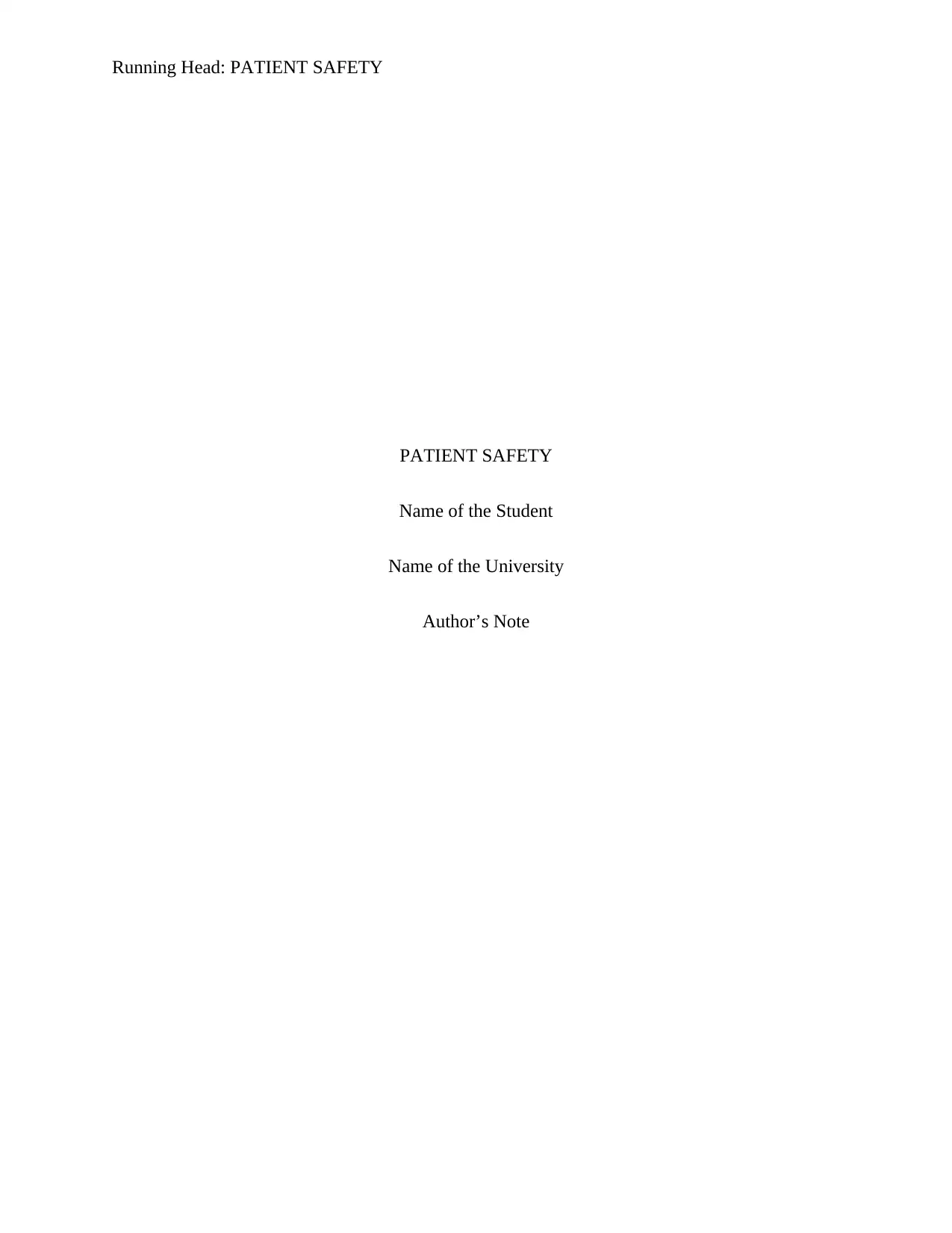
Running Head: PATIENT SAFETY
PATIENT SAFETY
Name of the Student
Name of the University
Author’s Note
PATIENT SAFETY
Name of the Student
Name of the University
Author’s Note
Paraphrase This Document
Need a fresh take? Get an instant paraphrase of this document with our AI Paraphraser
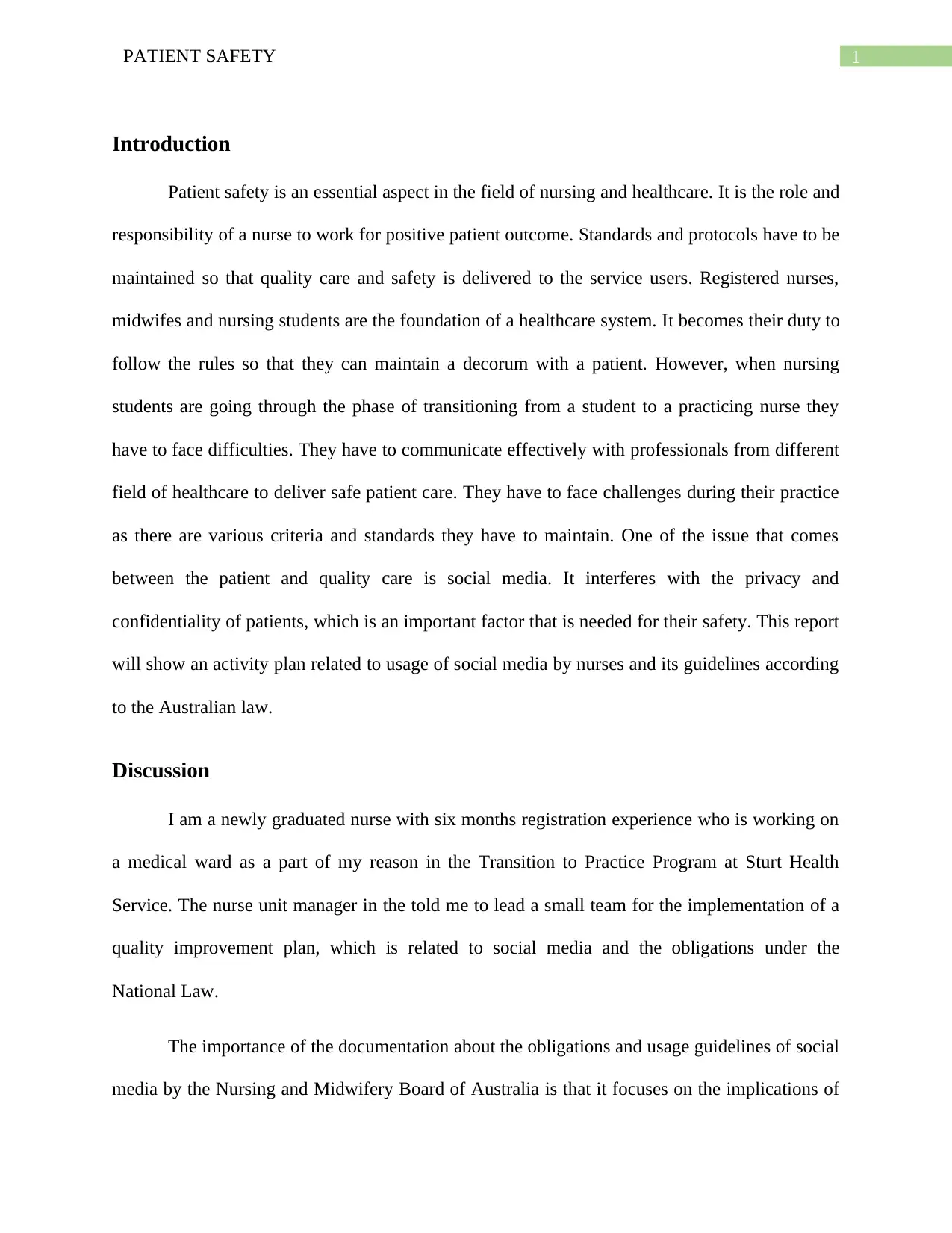
1PATIENT SAFETY
Introduction
Patient safety is an essential aspect in the field of nursing and healthcare. It is the role and
responsibility of a nurse to work for positive patient outcome. Standards and protocols have to be
maintained so that quality care and safety is delivered to the service users. Registered nurses,
midwifes and nursing students are the foundation of a healthcare system. It becomes their duty to
follow the rules so that they can maintain a decorum with a patient. However, when nursing
students are going through the phase of transitioning from a student to a practicing nurse they
have to face difficulties. They have to communicate effectively with professionals from different
field of healthcare to deliver safe patient care. They have to face challenges during their practice
as there are various criteria and standards they have to maintain. One of the issue that comes
between the patient and quality care is social media. It interferes with the privacy and
confidentiality of patients, which is an important factor that is needed for their safety. This report
will show an activity plan related to usage of social media by nurses and its guidelines according
to the Australian law.
Discussion
I am a newly graduated nurse with six months registration experience who is working on
a medical ward as a part of my reason in the Transition to Practice Program at Sturt Health
Service. The nurse unit manager in the told me to lead a small team for the implementation of a
quality improvement plan, which is related to social media and the obligations under the
National Law.
The importance of the documentation about the obligations and usage guidelines of social
media by the Nursing and Midwifery Board of Australia is that it focuses on the implications of
Introduction
Patient safety is an essential aspect in the field of nursing and healthcare. It is the role and
responsibility of a nurse to work for positive patient outcome. Standards and protocols have to be
maintained so that quality care and safety is delivered to the service users. Registered nurses,
midwifes and nursing students are the foundation of a healthcare system. It becomes their duty to
follow the rules so that they can maintain a decorum with a patient. However, when nursing
students are going through the phase of transitioning from a student to a practicing nurse they
have to face difficulties. They have to communicate effectively with professionals from different
field of healthcare to deliver safe patient care. They have to face challenges during their practice
as there are various criteria and standards they have to maintain. One of the issue that comes
between the patient and quality care is social media. It interferes with the privacy and
confidentiality of patients, which is an important factor that is needed for their safety. This report
will show an activity plan related to usage of social media by nurses and its guidelines according
to the Australian law.
Discussion
I am a newly graduated nurse with six months registration experience who is working on
a medical ward as a part of my reason in the Transition to Practice Program at Sturt Health
Service. The nurse unit manager in the told me to lead a small team for the implementation of a
quality improvement plan, which is related to social media and the obligations under the
National Law.
The importance of the documentation about the obligations and usage guidelines of social
media by the Nursing and Midwifery Board of Australia is that it focuses on the implications of
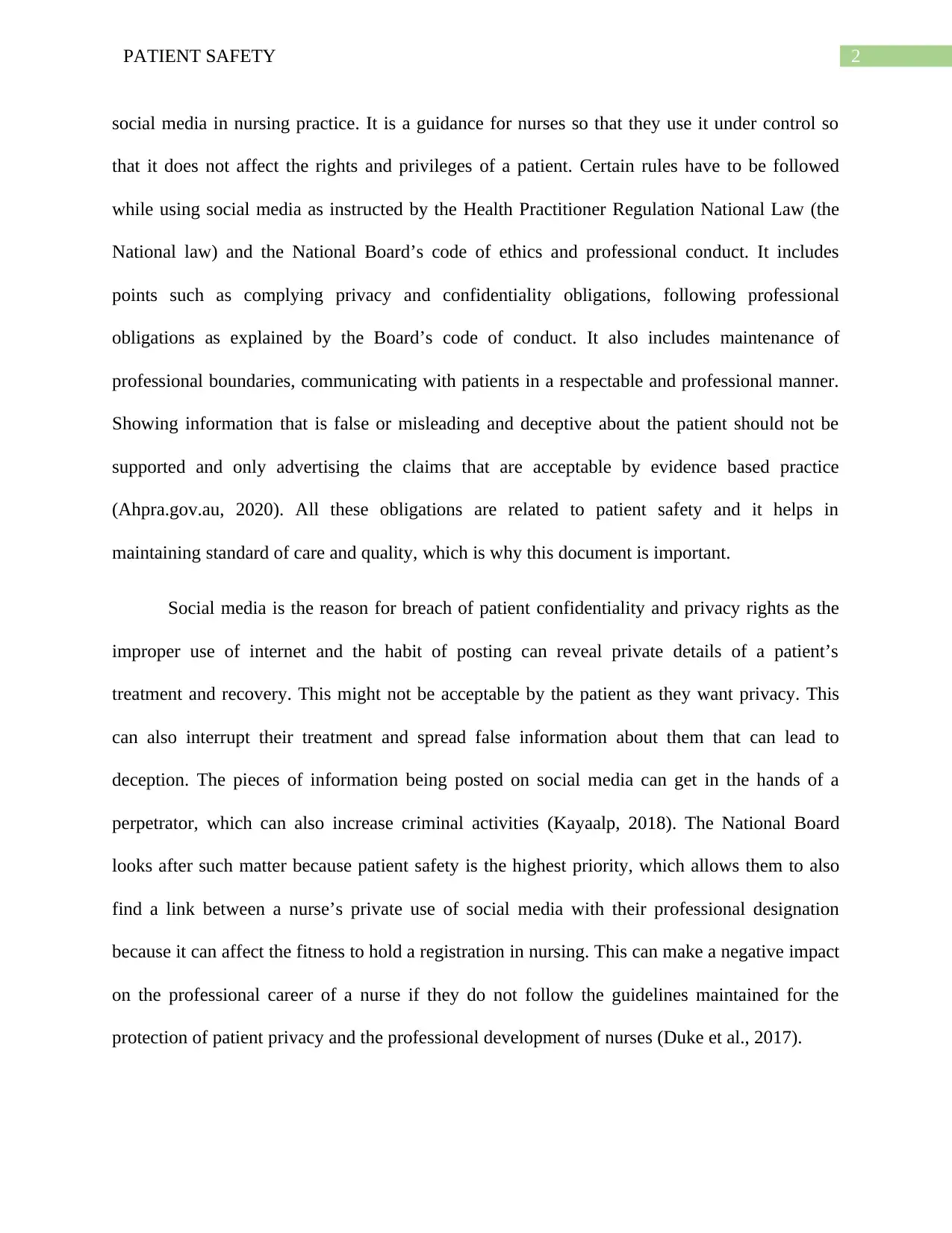
2PATIENT SAFETY
social media in nursing practice. It is a guidance for nurses so that they use it under control so
that it does not affect the rights and privileges of a patient. Certain rules have to be followed
while using social media as instructed by the Health Practitioner Regulation National Law (the
National law) and the National Board’s code of ethics and professional conduct. It includes
points such as complying privacy and confidentiality obligations, following professional
obligations as explained by the Board’s code of conduct. It also includes maintenance of
professional boundaries, communicating with patients in a respectable and professional manner.
Showing information that is false or misleading and deceptive about the patient should not be
supported and only advertising the claims that are acceptable by evidence based practice
(Ahpra.gov.au, 2020). All these obligations are related to patient safety and it helps in
maintaining standard of care and quality, which is why this document is important.
Social media is the reason for breach of patient confidentiality and privacy rights as the
improper use of internet and the habit of posting can reveal private details of a patient’s
treatment and recovery. This might not be acceptable by the patient as they want privacy. This
can also interrupt their treatment and spread false information about them that can lead to
deception. The pieces of information being posted on social media can get in the hands of a
perpetrator, which can also increase criminal activities (Kayaalp, 2018). The National Board
looks after such matter because patient safety is the highest priority, which allows them to also
find a link between a nurse’s private use of social media with their professional designation
because it can affect the fitness to hold a registration in nursing. This can make a negative impact
on the professional career of a nurse if they do not follow the guidelines maintained for the
protection of patient privacy and the professional development of nurses (Duke et al., 2017).
social media in nursing practice. It is a guidance for nurses so that they use it under control so
that it does not affect the rights and privileges of a patient. Certain rules have to be followed
while using social media as instructed by the Health Practitioner Regulation National Law (the
National law) and the National Board’s code of ethics and professional conduct. It includes
points such as complying privacy and confidentiality obligations, following professional
obligations as explained by the Board’s code of conduct. It also includes maintenance of
professional boundaries, communicating with patients in a respectable and professional manner.
Showing information that is false or misleading and deceptive about the patient should not be
supported and only advertising the claims that are acceptable by evidence based practice
(Ahpra.gov.au, 2020). All these obligations are related to patient safety and it helps in
maintaining standard of care and quality, which is why this document is important.
Social media is the reason for breach of patient confidentiality and privacy rights as the
improper use of internet and the habit of posting can reveal private details of a patient’s
treatment and recovery. This might not be acceptable by the patient as they want privacy. This
can also interrupt their treatment and spread false information about them that can lead to
deception. The pieces of information being posted on social media can get in the hands of a
perpetrator, which can also increase criminal activities (Kayaalp, 2018). The National Board
looks after such matter because patient safety is the highest priority, which allows them to also
find a link between a nurse’s private use of social media with their professional designation
because it can affect the fitness to hold a registration in nursing. This can make a negative impact
on the professional career of a nurse if they do not follow the guidelines maintained for the
protection of patient privacy and the professional development of nurses (Duke et al., 2017).
⊘ This is a preview!⊘
Do you want full access?
Subscribe today to unlock all pages.

Trusted by 1+ million students worldwide
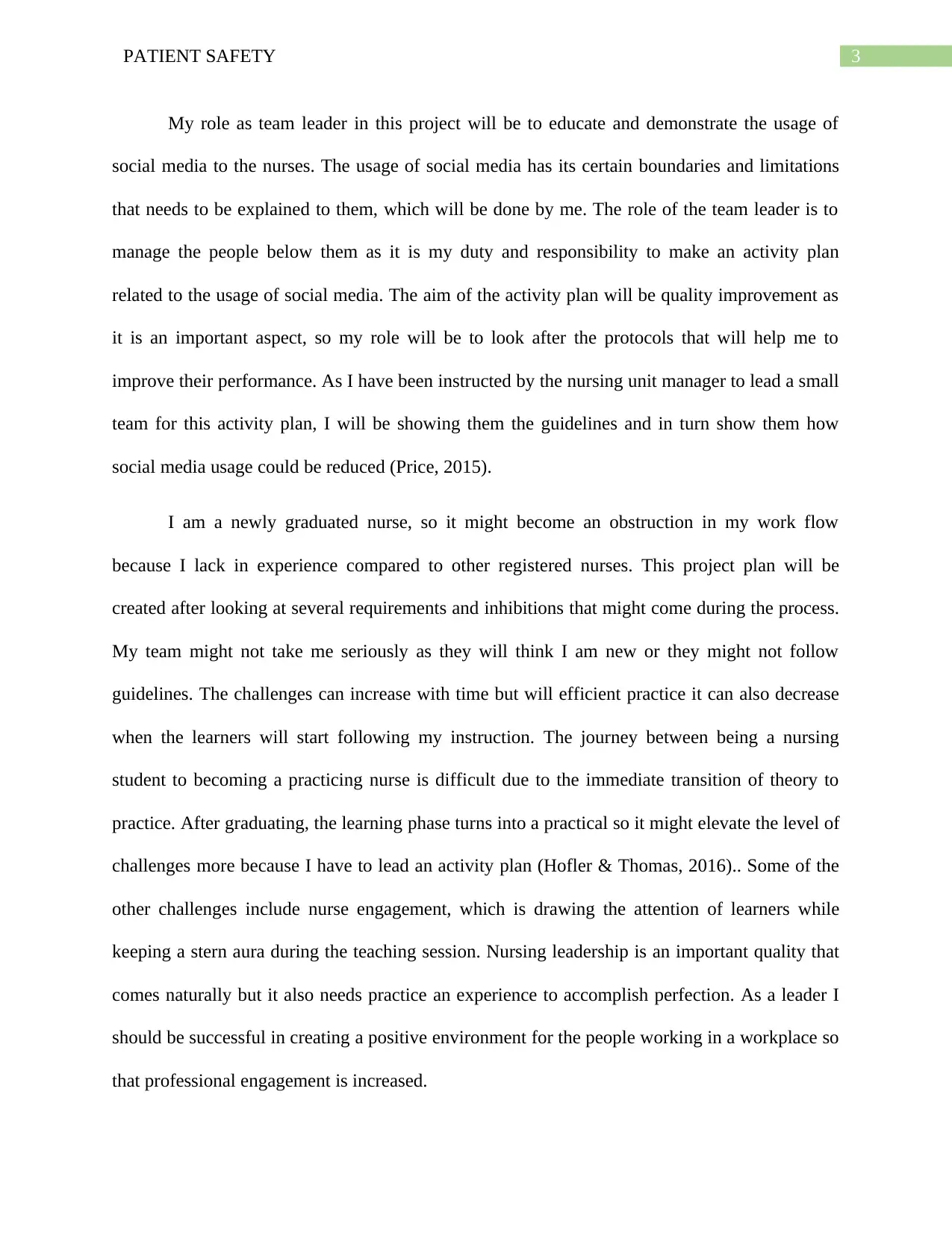
3PATIENT SAFETY
My role as team leader in this project will be to educate and demonstrate the usage of
social media to the nurses. The usage of social media has its certain boundaries and limitations
that needs to be explained to them, which will be done by me. The role of the team leader is to
manage the people below them as it is my duty and responsibility to make an activity plan
related to the usage of social media. The aim of the activity plan will be quality improvement as
it is an important aspect, so my role will be to look after the protocols that will help me to
improve their performance. As I have been instructed by the nursing unit manager to lead a small
team for this activity plan, I will be showing them the guidelines and in turn show them how
social media usage could be reduced (Price, 2015).
I am a newly graduated nurse, so it might become an obstruction in my work flow
because I lack in experience compared to other registered nurses. This project plan will be
created after looking at several requirements and inhibitions that might come during the process.
My team might not take me seriously as they will think I am new or they might not follow
guidelines. The challenges can increase with time but will efficient practice it can also decrease
when the learners will start following my instruction. The journey between being a nursing
student to becoming a practicing nurse is difficult due to the immediate transition of theory to
practice. After graduating, the learning phase turns into a practical so it might elevate the level of
challenges more because I have to lead an activity plan (Hofler & Thomas, 2016).. Some of the
other challenges include nurse engagement, which is drawing the attention of learners while
keeping a stern aura during the teaching session. Nursing leadership is an important quality that
comes naturally but it also needs practice an experience to accomplish perfection. As a leader I
should be successful in creating a positive environment for the people working in a workplace so
that professional engagement is increased.
My role as team leader in this project will be to educate and demonstrate the usage of
social media to the nurses. The usage of social media has its certain boundaries and limitations
that needs to be explained to them, which will be done by me. The role of the team leader is to
manage the people below them as it is my duty and responsibility to make an activity plan
related to the usage of social media. The aim of the activity plan will be quality improvement as
it is an important aspect, so my role will be to look after the protocols that will help me to
improve their performance. As I have been instructed by the nursing unit manager to lead a small
team for this activity plan, I will be showing them the guidelines and in turn show them how
social media usage could be reduced (Price, 2015).
I am a newly graduated nurse, so it might become an obstruction in my work flow
because I lack in experience compared to other registered nurses. This project plan will be
created after looking at several requirements and inhibitions that might come during the process.
My team might not take me seriously as they will think I am new or they might not follow
guidelines. The challenges can increase with time but will efficient practice it can also decrease
when the learners will start following my instruction. The journey between being a nursing
student to becoming a practicing nurse is difficult due to the immediate transition of theory to
practice. After graduating, the learning phase turns into a practical so it might elevate the level of
challenges more because I have to lead an activity plan (Hofler & Thomas, 2016).. Some of the
other challenges include nurse engagement, which is drawing the attention of learners while
keeping a stern aura during the teaching session. Nursing leadership is an important quality that
comes naturally but it also needs practice an experience to accomplish perfection. As a leader I
should be successful in creating a positive environment for the people working in a workplace so
that professional engagement is increased.
Paraphrase This Document
Need a fresh take? Get an instant paraphrase of this document with our AI Paraphraser
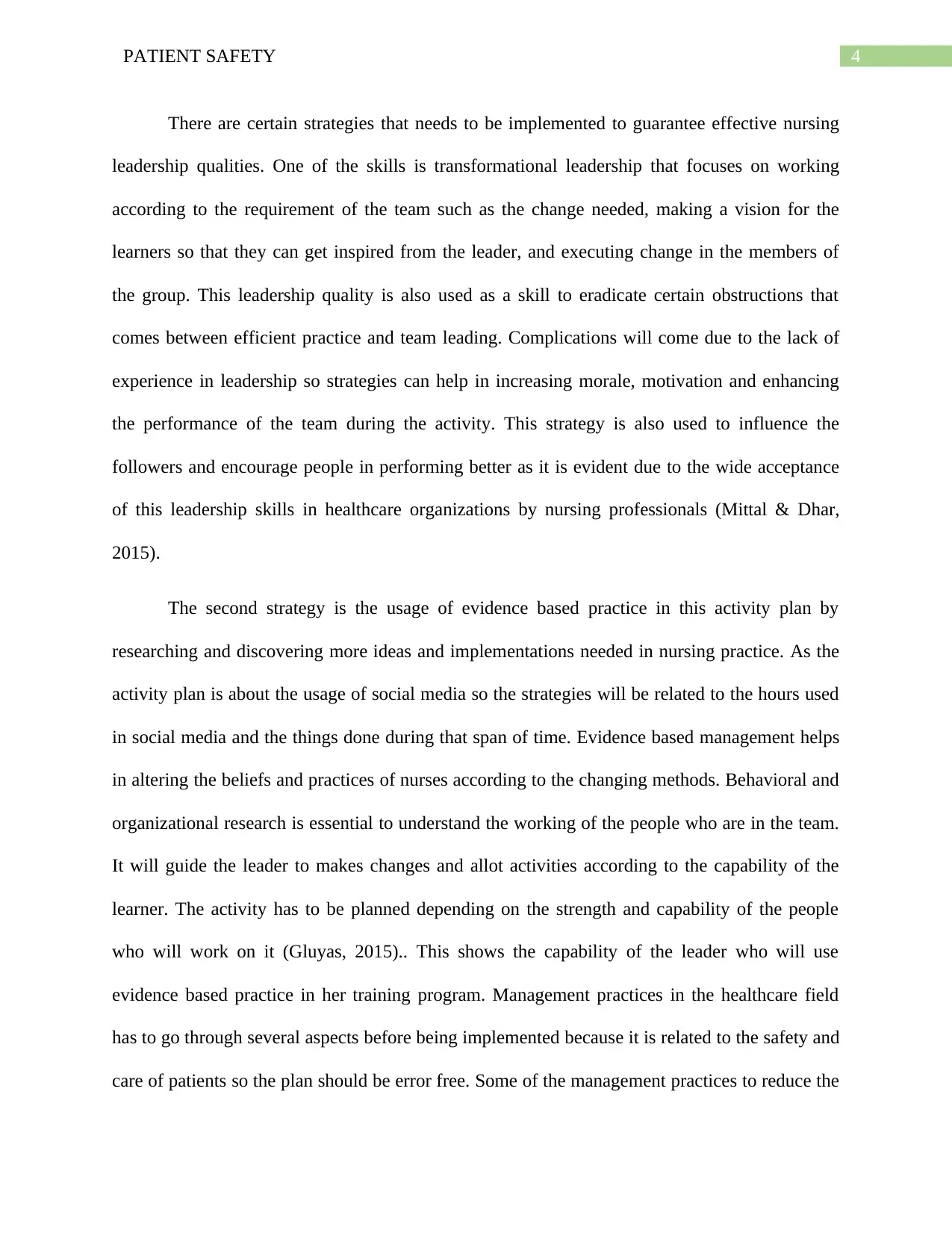
4PATIENT SAFETY
There are certain strategies that needs to be implemented to guarantee effective nursing
leadership qualities. One of the skills is transformational leadership that focuses on working
according to the requirement of the team such as the change needed, making a vision for the
learners so that they can get inspired from the leader, and executing change in the members of
the group. This leadership quality is also used as a skill to eradicate certain obstructions that
comes between efficient practice and team leading. Complications will come due to the lack of
experience in leadership so strategies can help in increasing morale, motivation and enhancing
the performance of the team during the activity. This strategy is also used to influence the
followers and encourage people in performing better as it is evident due to the wide acceptance
of this leadership skills in healthcare organizations by nursing professionals (Mittal & Dhar,
2015).
The second strategy is the usage of evidence based practice in this activity plan by
researching and discovering more ideas and implementations needed in nursing practice. As the
activity plan is about the usage of social media so the strategies will be related to the hours used
in social media and the things done during that span of time. Evidence based management helps
in altering the beliefs and practices of nurses according to the changing methods. Behavioral and
organizational research is essential to understand the working of the people who are in the team.
It will guide the leader to makes changes and allot activities according to the capability of the
learner. The activity has to be planned depending on the strength and capability of the people
who will work on it (Gluyas, 2015).. This shows the capability of the leader who will use
evidence based practice in her training program. Management practices in the healthcare field
has to go through several aspects before being implemented because it is related to the safety and
care of patients so the plan should be error free. Some of the management practices to reduce the
There are certain strategies that needs to be implemented to guarantee effective nursing
leadership qualities. One of the skills is transformational leadership that focuses on working
according to the requirement of the team such as the change needed, making a vision for the
learners so that they can get inspired from the leader, and executing change in the members of
the group. This leadership quality is also used as a skill to eradicate certain obstructions that
comes between efficient practice and team leading. Complications will come due to the lack of
experience in leadership so strategies can help in increasing morale, motivation and enhancing
the performance of the team during the activity. This strategy is also used to influence the
followers and encourage people in performing better as it is evident due to the wide acceptance
of this leadership skills in healthcare organizations by nursing professionals (Mittal & Dhar,
2015).
The second strategy is the usage of evidence based practice in this activity plan by
researching and discovering more ideas and implementations needed in nursing practice. As the
activity plan is about the usage of social media so the strategies will be related to the hours used
in social media and the things done during that span of time. Evidence based management helps
in altering the beliefs and practices of nurses according to the changing methods. Behavioral and
organizational research is essential to understand the working of the people who are in the team.
It will guide the leader to makes changes and allot activities according to the capability of the
learner. The activity has to be planned depending on the strength and capability of the people
who will work on it (Gluyas, 2015).. This shows the capability of the leader who will use
evidence based practice in her training program. Management practices in the healthcare field
has to go through several aspects before being implemented because it is related to the safety and
care of patients so the plan should be error free. Some of the management practices to reduce the
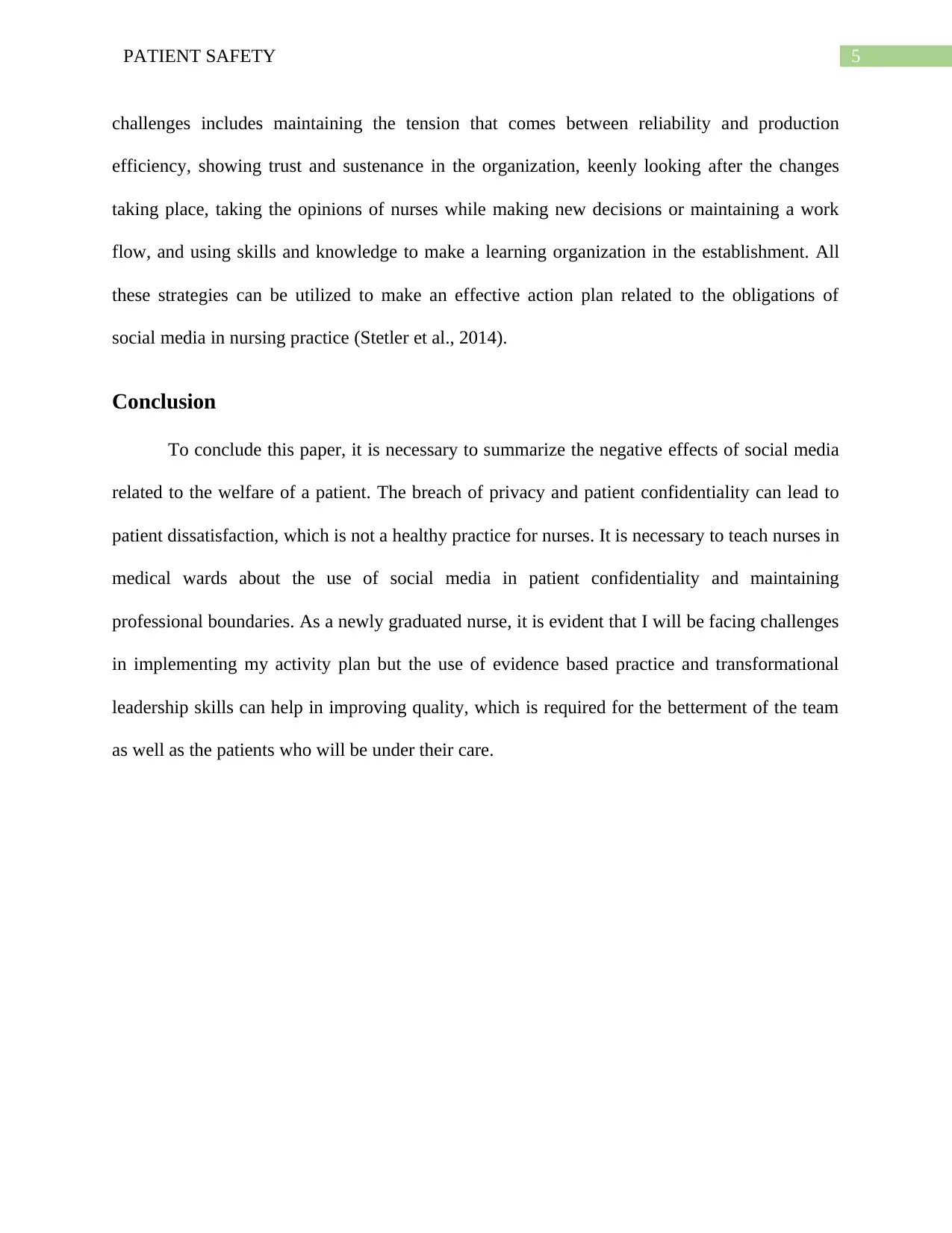
5PATIENT SAFETY
challenges includes maintaining the tension that comes between reliability and production
efficiency, showing trust and sustenance in the organization, keenly looking after the changes
taking place, taking the opinions of nurses while making new decisions or maintaining a work
flow, and using skills and knowledge to make a learning organization in the establishment. All
these strategies can be utilized to make an effective action plan related to the obligations of
social media in nursing practice (Stetler et al., 2014).
Conclusion
To conclude this paper, it is necessary to summarize the negative effects of social media
related to the welfare of a patient. The breach of privacy and patient confidentiality can lead to
patient dissatisfaction, which is not a healthy practice for nurses. It is necessary to teach nurses in
medical wards about the use of social media in patient confidentiality and maintaining
professional boundaries. As a newly graduated nurse, it is evident that I will be facing challenges
in implementing my activity plan but the use of evidence based practice and transformational
leadership skills can help in improving quality, which is required for the betterment of the team
as well as the patients who will be under their care.
challenges includes maintaining the tension that comes between reliability and production
efficiency, showing trust and sustenance in the organization, keenly looking after the changes
taking place, taking the opinions of nurses while making new decisions or maintaining a work
flow, and using skills and knowledge to make a learning organization in the establishment. All
these strategies can be utilized to make an effective action plan related to the obligations of
social media in nursing practice (Stetler et al., 2014).
Conclusion
To conclude this paper, it is necessary to summarize the negative effects of social media
related to the welfare of a patient. The breach of privacy and patient confidentiality can lead to
patient dissatisfaction, which is not a healthy practice for nurses. It is necessary to teach nurses in
medical wards about the use of social media in patient confidentiality and maintaining
professional boundaries. As a newly graduated nurse, it is evident that I will be facing challenges
in implementing my activity plan but the use of evidence based practice and transformational
leadership skills can help in improving quality, which is required for the betterment of the team
as well as the patients who will be under their care.
⊘ This is a preview!⊘
Do you want full access?
Subscribe today to unlock all pages.

Trusted by 1+ million students worldwide
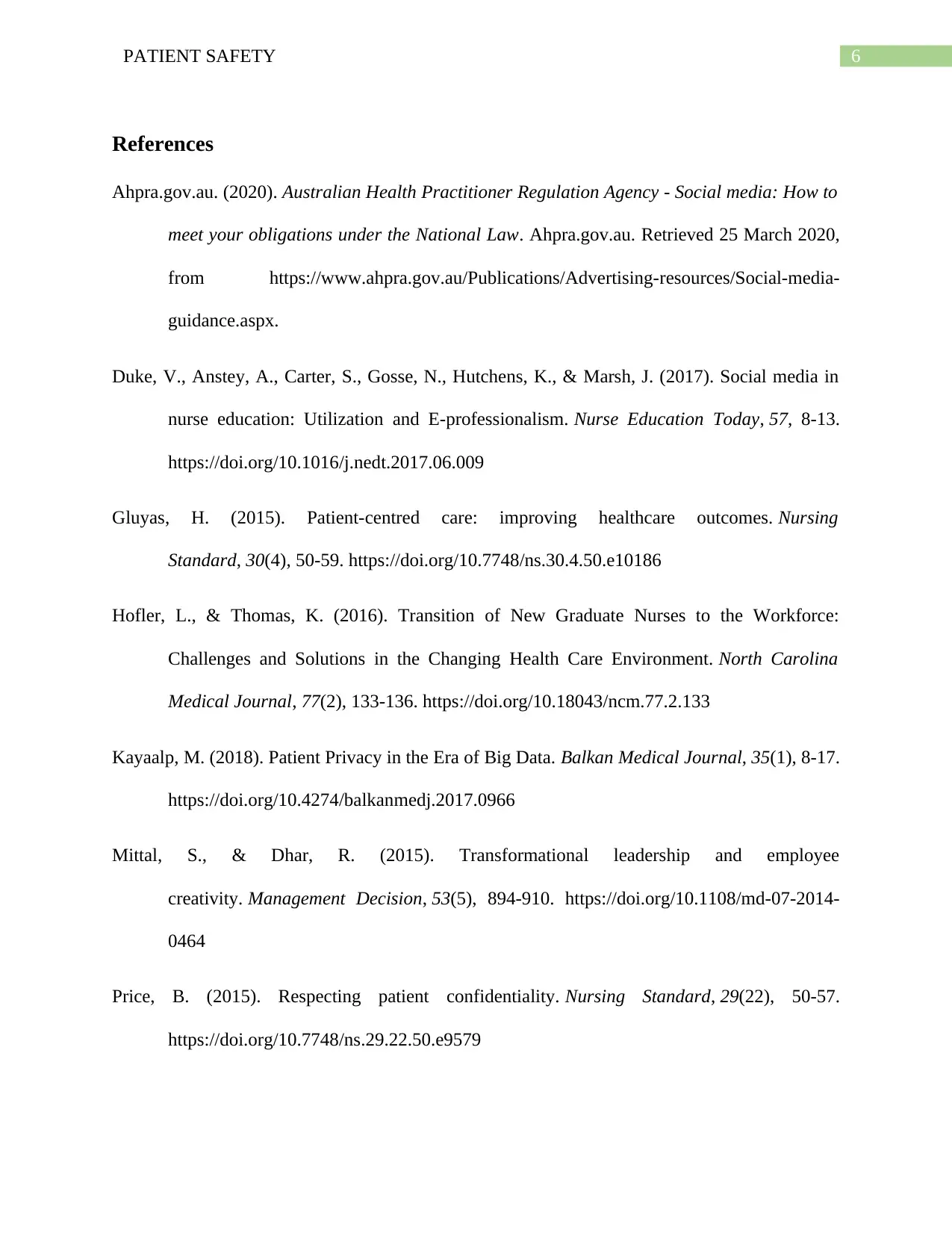
6PATIENT SAFETY
References
Ahpra.gov.au. (2020). Australian Health Practitioner Regulation Agency - Social media: How to
meet your obligations under the National Law. Ahpra.gov.au. Retrieved 25 March 2020,
from https://www.ahpra.gov.au/Publications/Advertising-resources/Social-media-
guidance.aspx.
Duke, V., Anstey, A., Carter, S., Gosse, N., Hutchens, K., & Marsh, J. (2017). Social media in
nurse education: Utilization and E-professionalism. Nurse Education Today, 57, 8-13.
https://doi.org/10.1016/j.nedt.2017.06.009
Gluyas, H. (2015). Patient-centred care: improving healthcare outcomes. Nursing
Standard, 30(4), 50-59. https://doi.org/10.7748/ns.30.4.50.e10186
Hofler, L., & Thomas, K. (2016). Transition of New Graduate Nurses to the Workforce:
Challenges and Solutions in the Changing Health Care Environment. North Carolina
Medical Journal, 77(2), 133-136. https://doi.org/10.18043/ncm.77.2.133
Kayaalp, M. (2018). Patient Privacy in the Era of Big Data. Balkan Medical Journal, 35(1), 8-17.
https://doi.org/10.4274/balkanmedj.2017.0966
Mittal, S., & Dhar, R. (2015). Transformational leadership and employee
creativity. Management Decision, 53(5), 894-910. https://doi.org/10.1108/md-07-2014-
0464
Price, B. (2015). Respecting patient confidentiality. Nursing Standard, 29(22), 50-57.
https://doi.org/10.7748/ns.29.22.50.e9579
References
Ahpra.gov.au. (2020). Australian Health Practitioner Regulation Agency - Social media: How to
meet your obligations under the National Law. Ahpra.gov.au. Retrieved 25 March 2020,
from https://www.ahpra.gov.au/Publications/Advertising-resources/Social-media-
guidance.aspx.
Duke, V., Anstey, A., Carter, S., Gosse, N., Hutchens, K., & Marsh, J. (2017). Social media in
nurse education: Utilization and E-professionalism. Nurse Education Today, 57, 8-13.
https://doi.org/10.1016/j.nedt.2017.06.009
Gluyas, H. (2015). Patient-centred care: improving healthcare outcomes. Nursing
Standard, 30(4), 50-59. https://doi.org/10.7748/ns.30.4.50.e10186
Hofler, L., & Thomas, K. (2016). Transition of New Graduate Nurses to the Workforce:
Challenges and Solutions in the Changing Health Care Environment. North Carolina
Medical Journal, 77(2), 133-136. https://doi.org/10.18043/ncm.77.2.133
Kayaalp, M. (2018). Patient Privacy in the Era of Big Data. Balkan Medical Journal, 35(1), 8-17.
https://doi.org/10.4274/balkanmedj.2017.0966
Mittal, S., & Dhar, R. (2015). Transformational leadership and employee
creativity. Management Decision, 53(5), 894-910. https://doi.org/10.1108/md-07-2014-
0464
Price, B. (2015). Respecting patient confidentiality. Nursing Standard, 29(22), 50-57.
https://doi.org/10.7748/ns.29.22.50.e9579
Paraphrase This Document
Need a fresh take? Get an instant paraphrase of this document with our AI Paraphraser
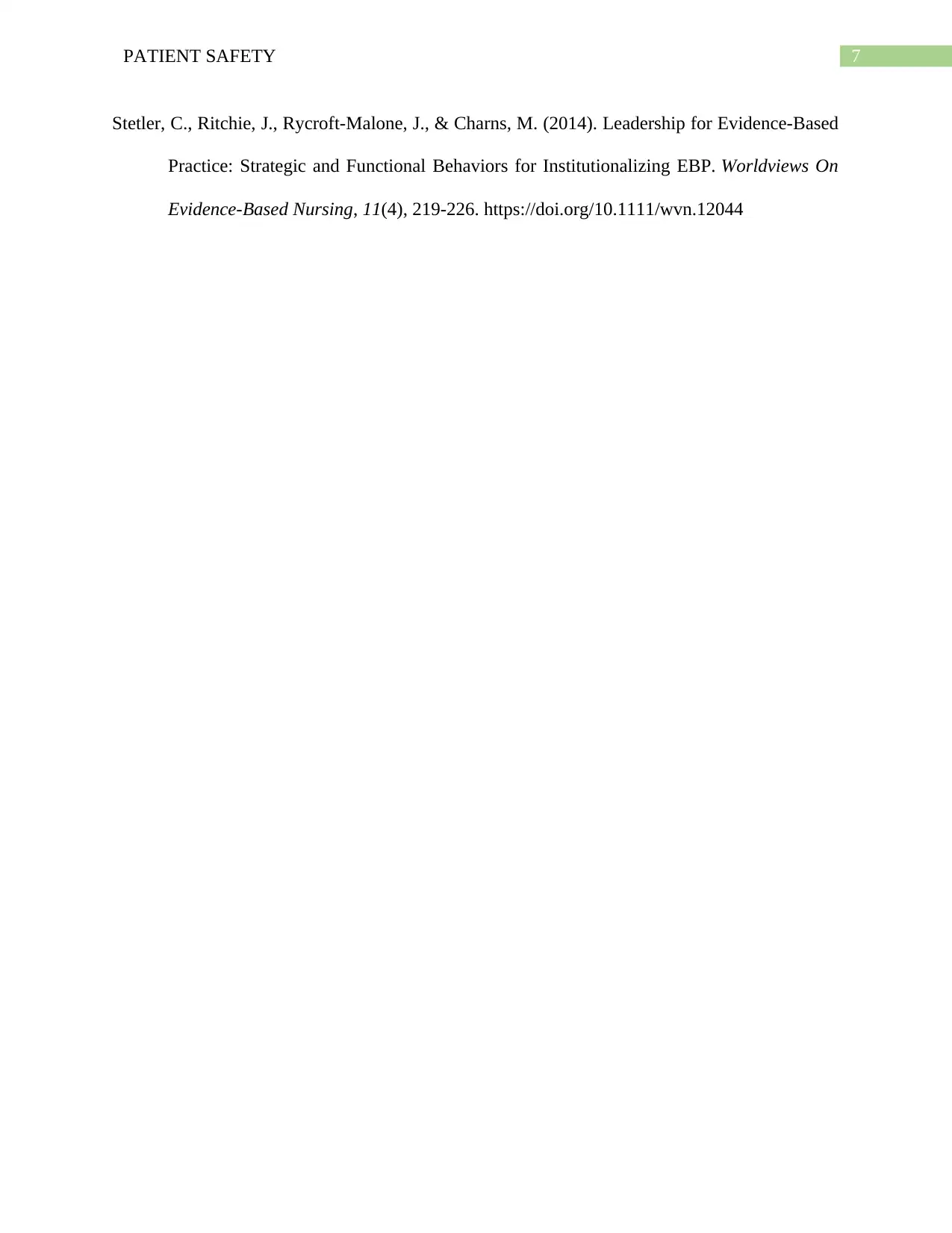
7PATIENT SAFETY
Stetler, C., Ritchie, J., Rycroft-Malone, J., & Charns, M. (2014). Leadership for Evidence-Based
Practice: Strategic and Functional Behaviors for Institutionalizing EBP. Worldviews On
Evidence-Based Nursing, 11(4), 219-226. https://doi.org/10.1111/wvn.12044
Stetler, C., Ritchie, J., Rycroft-Malone, J., & Charns, M. (2014). Leadership for Evidence-Based
Practice: Strategic and Functional Behaviors for Institutionalizing EBP. Worldviews On
Evidence-Based Nursing, 11(4), 219-226. https://doi.org/10.1111/wvn.12044
1 out of 8
Related Documents
Your All-in-One AI-Powered Toolkit for Academic Success.
+13062052269
info@desklib.com
Available 24*7 on WhatsApp / Email
![[object Object]](/_next/static/media/star-bottom.7253800d.svg)
Unlock your academic potential
Copyright © 2020–2025 A2Z Services. All Rights Reserved. Developed and managed by ZUCOL.





